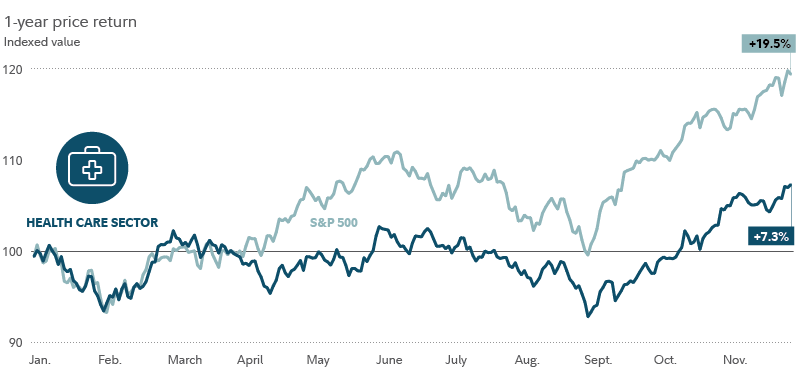The past year may be remembered as a groundbreaking period for the health care sector, due to the excitement surrounding promising new weight-loss drugs that have quickly become highly sought after worldwide. It may also be remembered as a period that divided major perceived “winners” and “losers” of these developments—with investors rewarding drug innovators and punishing some providers of traditional treatments for diabetes and obesity.
This year, it’s impossible to predict what stocks or segments investors may favor. But the health care sector could have a strong setup, given recent low valuations combined with new products and long-term trends that may continue to play out.
Coming off a year of innovation
Just as investor excitement over artificial intelligence drove returns in the technology and communication services sectors in the past year, investor enthusiasm for weight-loss drugs was a key driver behind health care stock returns.
On the upside, stocks of the producers of these drugs experienced significant gains. On the downside, some stocks of health care equipment makers that serve the diabetes market—such as makers of insulin pumps—experienced losses as investors became concerned over how weight-loss drugs might hurt long-term demand for diabetes devices.
Health care utilization also ticked higher as patients who delayed surgeries and treatment during the pandemic continued to seek services in hospitals, doctor offices, and ambulatory care centers in increased numbers. This generally supported groups like health care facilities and medical-device manufacturers, but weighed on the stocks of managed-care health insurers.
More important to sector-level returns, health care as a whole simply has not been in favor with investors in the past year. Health care stocks tend to be viewed as defensive, given that people generally go to the doctor and take their medications regardless of what's going on in the economy. This reputation was a disadvantage in the past year as investors favored mega-cap growth stocks (particularly those of large tech companies seen as potential plays on artificial intelligence), over defensive sectors. This fueled the sector’s overall lagging returns.

Attractive valuations and long-term potential
Looking ahead, the performance of health care stocks may be heavily influenced by the direction of the broader economy and the current starting point of valuations. While I can't be sure of where the economy is headed, the low starting point of valuations may be a positive for the sector.
Fund top holdings1
Top-10 holdings of the Fidelity® Select Health Care Portfolio (
- 9.5% – UnitedHealth Group Inc. (
) - 9.0% – Boston Scientific Corp. (
) - 7.3% – Eli Lilly & Co. (
) - 6.4% – Danaher Corp. (
) - 4.5% – CVS Health Corp. (
) - 4.4% – Regeneron Pharmaceuticals Inc. (
) - 4.3% – Thermo Fisher Scientific Inc. (
) - 4.0% – Penumbra Inc. (
) - 3.9% – Cigna Group (
) - 2.9% – Merck & Co. (
)
(See the most recent fund information.)
The new-generation weight-loss drugs, namely Novo Nordisk's Ozempic® and Wegovy®, and Eli Lilly's (
The potential market for these drugs is extensive: An estimated 38 million Americans have diabetes (with almost 9 million of those cases estimated to be undiagnosed).2 Some 60 million European adults are estimated to have diabetes,3 while the prevalence in developing markets has been rising. Meanwhile, there are estimated to be more than 500 million obese adults globally.4 As a result, these new weight-loss drugs (which are known as glucagon-like peptide-1, or GLP-1, agonists), could be a large class of drugs for the world for an extended period.
However, investors may have underestimated how long it will take for these drugs to be broadly adopted, and how long it will take for them to potentially hurt demand for existing diabetes and obesity treatments. This has created some interesting opportunities in areas of the market that underperformed on GLP-1 exuberance, including firms like Insulet (
Another long-term trend I have continued to find interesting is the transformation in health insurance. In the US, a gradual transition has been underway, from a traditional fee-for-service model (in which providers are compensated based on the volume of visits and services they provide) to a value-based model (in which physicians are compensated based on patient outcomes rather than on service volumes). While stocks of managed-care companies were hampered in the past year by some of the short-term headwinds mentioned above, some could be poised to benefit from this long-term transformation. UnitedHealth Group (
A focus on the long term
No matter where US markets are headed next, the health care sector can offer a combination of defensive and growth characteristics that may be attractive in a variety of scenarios. But my focus remains on the long term—that is, trying to invest in the most innovative areas of health care, where Fidelity's research insights may help deliver material value over time.

Edward (Eddie) Yoon is a sector leader and portfolio manager in the Equity division at Fidelity Investments. Fidelity Investments is a leading provider of investment management, retirement planning, portfolio guidance, brokerage, benefits outsourcing, and other financial products and services to institutions, financial intermediaries, and individuals.
In this role, Mr. Yoon is responsible for the coverage of health care equipment and supplies stocks, and serves as the health care sector leader. Additionally, he manages several funds including Fidelity Advisor Health Care Fund, Fidelity and Fidelity Advisor Stock Selector Mid Cap Fund, Fidelity and Fidelity Advisor All Cap Fund, Fidelity Select Health Care Portfolio, and Fidelity Select Medical Technology and Devices Portfolio.
Prior to joining Fidelity in 2006, Mr. Yoon worked on the health care team at JPMorgan Asset Management. He has been in the financial industry since 2002.
Mr. Yoon earned his bachelor of arts degree in business economics from Brown University.


